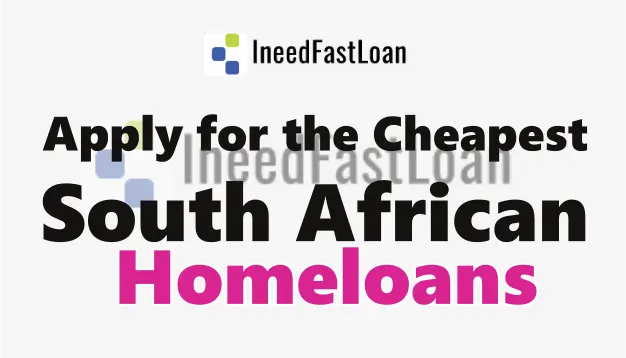Apply for the Cheapest South African Homeloans

Securing a home loan in South Africa can be a daunting task, especially for first-time homebuyers. The process involves various steps, from understanding the types of home loans available to gathering the necessary documentation and comparing interest rates. The goal for many is to find the cheapest South African homeloans that suit their financial situation and long-term goals. This comprehensive guide will provide you with the necessary information and strategies to apply for and secure the most affordable home loan in South Africa.
What you Need to Know About Home Loans in South Africa
Types of South African Homeloans
In South Africa, there are several types of home loans available to prospective buyers:
- Fixed-Rate Home Loans: The interest rate remains the same throughout the loan term, providing stability and predictability in monthly repayments.
- Variable-Rate Home Loans: The interest rate fluctuates based on the market conditions. While this can offer lower rates during certain periods, it also means that repayments can increase when interest rates rise.
- Capped-Rate Home Loans: These loans have a variable interest rate but with an upper limit (cap), ensuring that the rate does not exceed a certain level.
- Offset Home Loans: This type links your home loan to your savings or current account. The balance in these accounts offsets the home loan balance, reducing the interest you pay.
- Step-Down Home Loans: Initially, the interest rate is higher, but it decreases over time. This option might be suitable for individuals expecting their income to increase in the future.
Key Terms to Know
- Interest Rate: The percentage charged by the lender on the loan amount.
- Loan Term: The period over which the loan is repaid.
- Principal: The initial amount borrowed.
- Repayment Plan: The schedule and amount of repayments over the loan term.
Steps to Apply for the Cheapest South African Homeloans
Step 1: Assess Your Financial Situation
Before applying for a home loan, it’s crucial to have a clear understanding of your financial health. This involves evaluating your income, expenses, debts, and savings. A comprehensive assessment will help determine how much you can afford to borrow and repay comfortably.
- Calculate Your Debt-to-Income Ratio: This ratio compares your total monthly debt payments to your monthly gross income. A lower ratio indicates a better financial position to manage loan repayments.
- Review Your Credit Score: Your credit score plays a significant role in loan approval and the interest rate offered. Obtain your credit report from credit bureaus like TransUnion, Experian, or Compuscan, and ensure it is accurate.
- Budget for Additional Costs: Besides the home loan repayments, budget for other costs such as insurance, property taxes, maintenance, and utility bills.
Step 2: Save for a Down Payment
The size of your down payment can significantly affect the terms of your home loan. A larger down payment reduces the loan amount and may lead to more favorable interest rates. Aim to save at least 10-20% of the property price as a down payment.
Step 3: Research Lenders and Loan Products
To find the cheapest South African homeloans, thorough research is essential. Compare different lenders and their loan products based on interest rates, fees, and repayment terms. Consider approaching traditional banks, credit unions, and online lenders.
- Interest Rates: Look for competitive interest rates. Even a slight difference can save you thousands over the loan term.
- Loan Fees: Be aware of additional fees such as application fees, legal fees, and valuation fees.
- Customer Service: Choose a lender with good customer service to ensure a smooth loan application process and support throughout the loan term.
Step 4: Get Pre-Approved
Obtaining pre-approval for a home loan gives you a clear idea of how much you can borrow and shows sellers that you are a serious buyer. Pre-approval involves a preliminary assessment of your financial situation by the lender and a credit check.
- Submit Required Documents: Typically, you’ll need to provide proof of income, bank statements, identification, and details of your debts and assets.
- Understand Pre-Approval Terms: Pre-approval is usually valid for a specific period, and it’s not a guarantee of final loan approval.
Step 5: Choose the Right South African Homeloans
Based on your research and pre-approval amount, choose the home loan that best fits your needs. Consider the following factors:
- Interest Rate Type: Decide between a fixed-rate, variable-rate, capped-rate, offset, or step-down home loan based on your financial situation and risk tolerance.
- Repayment Flexibility: Some loans offer flexible repayment options, such as making extra payments without penalties.
- Additional Features: Look for features like redraw facilities, which allow you to access extra repayments you’ve made if needed.
Step 6: Apply for the Loan
Once you’ve chosen the South African homeloans, the next step is to formally apply. This involves submitting a detailed application form along with all required documentation.
- Complete the Application Form: Provide accurate information about your personal details, employment, income, expenses, and the property you intend to purchase.
- Submit Documentation: Include proof of income (pay slips, tax returns), bank statements, identification, and any other documents requested by the lender.
- Wait for Approval: The lender will assess your application, which may include a property valuation and further credit checks. This process can take a few days to a few weeks.
Tips to Secure the Cheapest South African Homeloans
Improve Your Credit Score
A higher credit score can lead to better loan terms and lower interest rates. To improve your credit score:
- Pay Bills on Time: Consistently paying your bills on time has a positive impact on your credit score.
- Reduce Debt: Lower your outstanding debts to improve your debt-to-income ratio.
- Limit Credit Applications: Avoid applying for multiple credit products in a short period, as this can negatively affect your score.
Compare Interest Rates and Fees
Interest rates and fees vary among lenders, so it’s essential to compare offers to find the cheapest home loan. Use online comparison tools and consult with mortgage brokers who can provide insights into the best deals.
Negotiate with Lenders
Don’t hesitate to negotiate with lenders for better terms. If you have a strong financial profile and a good credit score, you may be able to secure lower interest rates or reduced fees.
Consider a Shorter Loan Term
While longer loan terms (e.g., 30 years) result in lower monthly repayments, shorter terms (e.g., 15 years) usually come with lower interest rates and less overall interest paid. Assess your financial situation to determine if you can afford higher monthly payments for a shorter loan term.
Utilize Government Programs
The South African government offers various programs to assist homebuyers, particularly first-time buyers. Research these programs to see if you qualify for any benefits or subsidies that can reduce your home loan costs.
Common Mistakes to Avoid When Applying for a South African Homeloans
Not Shopping Around
Failing to compare different lenders and loan products can result in higher interest rates and fees. Take the time to shop around and evaluate multiple options.
Overextending Your Budget
Borrowing more than you can comfortably afford can lead to financial strain. Stick to your budget and avoid the temptation to buy a more expensive property than you can manage.
Ignoring Additional Costs
Beyond the loan repayments, there are other costs associated with homeownership, such as maintenance, insurance, and property taxes. Factor these into your budget to avoid surprises.
Skipping Pre-Approval
Skipping the pre-approval process can lead to delays and complications when you find a property you want to purchase. Pre-approval gives you a clear idea of your borrowing capacity and strengthens your position as a buyer.
Not Reviewing Loan Terms
Thoroughly review the loan terms and conditions before signing. Ensure you understand the interest rate, fees, repayment schedule, and any penalties for early repayment.
Conclusion
Applying for the cheapest South African homeloans requires thorough research, careful financial planning, and a strategic approach. By understanding the different types of South African Homeloans, assessing your financial situation, and comparing lenders, you can secure a loan that suits your needs and budget.
Recommended: Top 20 Quick Loans For Blacklisted In South Africa
Remember to improve your credit score, save for a substantial down payment, and utilize government programs to further reduce your costs. Avoid common mistakes and stay informed throughout the process to make confident decisions and achieve your homeownership goals in South Africa.
FAQs about Applying for the Cheapest South African Homeloans
-
What factors influence the interest rates on South African homeloans?
Interest rates on South African homeloans are influenced by several factors, including your credit score, the size of your down payment, the loan term, and the type of loan you choose. Economic conditions and the South African Reserve Bank’s interest rate policies also play a significant role.
-
How can I improve my chances of getting approved for a home loan?
To improve your chances of getting approved for a home loan, maintain a good credit score, reduce your existing debt, save for a substantial down payment, and ensure your income is stable and well-documented. It’s also beneficial to get pre-approved to show sellers you are a serious buyer.
-
What are the additional costs associated with taking out a home loan?
Additional costs associated with taking out a home loan include application fees, legal fees, valuation fees, property insurance, transfer duties, and ongoing costs such as property taxes and maintenance. It’s important to budget for these expenses in addition to your monthly loan repayments.
-
Are there government programs available to help first-time homebuyers in South Africa?
Yes, the South African government offers several programs to assist first-time homebuyers, such as the Finance Linked Individual Subsidy Programme (FLISP). These programs provide financial assistance to lower-income households to help make homeownership more affordable.
-
What is the difference between a fixed-rate and a variable-rate home loan?
A fixed-rate home loan has an interest rate that remains the same throughout the loan term, providing stability in your monthly repayments. A variable-rate home loan, on the other hand, has an interest rate that fluctuates based on market conditions, which means your monthly repayments can increase or decrease over time



